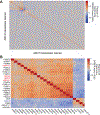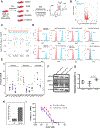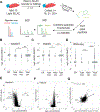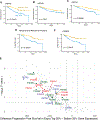Allosteric HSP70 inhibitors perturb mitochondrial proteostasis and overcome proteasome inhibitor resistance in multiple myeloma
- PMID: 35853457
- PMCID: PMC9434701
- DOI: 10.1016/j.chembiol.2022.06.010
Allosteric HSP70 inhibitors perturb mitochondrial proteostasis and overcome proteasome inhibitor resistance in multiple myeloma
Abstract
Proteasome inhibitor (PI) resistance remains a central challenge in multiple myeloma. To identify pathways mediating resistance, we first mapped proteasome-associated genetic co-dependencies. We identified heat shock protein 70 (HSP70) chaperones as potential targets, consistent with proposed mechanisms of myeloma cells overcoming PI-induced stress. We therefore explored allosteric HSP70 inhibitors (JG compounds) as myeloma therapeutics. JG compounds exhibited increased efficacy against acquired and intrinsic PI-resistant myeloma models, unlike HSP90 inhibition. Shotgun and pulsed SILAC mass spectrometry demonstrated that JGs unexpectedly impact myeloma proteostasis by destabilizing the 55S mitoribosome. Our data suggest JGs have the most pronounced anti-myeloma effect not through inhibiting cytosolic HSP70 proteins but instead through mitochondrial-localized HSP70, HSPA9/mortalin. Analysis of myeloma patient data further supports strong effects of global proteostasis capacity, and particularly HSPA9 expression, on PI response. Our results characterize myeloma proteostasis networks under therapeutic pressure while motivating further investigation of HSPA9 as a specific vulnerability in PI-resistant disease.
Keywords: HSP70; bortezomib; mitochondria; mitoribosome; myeloma; proteasome inhibitor; proteomics; proteostasis; resistance.
Copyright © 2022 Elsevier Ltd. All rights reserved.
Conflict of interest statement
Declaration of interests J.E.G. and H.S. have filed a patent related to the structures of the JG compounds. A.P.W. is an equity holder and scientific advisory board member of Indapta Therapeutics and Protocol Intelligence. The other authors declare no competing interests.
Figures






Similar articles
-
Impact of proteostasis workload on sensitivity to proteasome inhibitors in multiple myeloma.Clin Exp Med. 2025 May 26;25(1):176. doi: 10.1007/s10238-025-01713-z. Clin Exp Med. 2025. PMID: 40418254 Free PMC article. Review.
-
Multiple myeloma cells are exceptionally sensitive to heat shock, which overwhelms their proteostasis network and induces apoptosis.Proc Natl Acad Sci U S A. 2020 Sep 1;117(35):21588-21597. doi: 10.1073/pnas.2001323117. Epub 2020 Aug 19. Proc Natl Acad Sci U S A. 2020. PMID: 32817432 Free PMC article.
-
A plastic SQSTM1/p62-dependent autophagic reserve maintains proteostasis and determines proteasome inhibitor susceptibility in multiple myeloma cells.Autophagy. 2015;11(7):1161-78. doi: 10.1080/15548627.2015.1052928. Autophagy. 2015. PMID: 26043024 Free PMC article.
-
Exosome-transmitted HSPA9 facilitates bortezomib resistance by targeting TRIP13/USP1 signaling in multiple myeloma.Cell Commun Signal. 2025 Mar 26;23(1):152. doi: 10.1186/s12964-025-02158-3. Cell Commun Signal. 2025. PMID: 40140922 Free PMC article.
-
Lessons Learned from Proteasome Inhibitors, the Paradigm for Targeting Protein Homeostasis in Cancer.Adv Exp Med Biol. 2020;1243:147-162. doi: 10.1007/978-3-030-40204-4_10. Adv Exp Med Biol. 2020. PMID: 32297217 Review.
Cited by
-
Mitoribosome sensitivity to HSP70 inhibition uncovers metabolic liabilities of castration-resistant prostate cancer.PNAS Nexus. 2023 Apr 3;2(4):pgad115. doi: 10.1093/pnasnexus/pgad115. eCollection 2023 Apr. PNAS Nexus. 2023. PMID: 37091547 Free PMC article.
-
Impact of proteostasis workload on sensitivity to proteasome inhibitors in multiple myeloma.Clin Exp Med. 2025 May 26;25(1):176. doi: 10.1007/s10238-025-01713-z. Clin Exp Med. 2025. PMID: 40418254 Free PMC article. Review.
-
Is It Still Possible to Think about HSP70 as a Therapeutic Target in Onco-Hematological Diseases?Biomolecules. 2023 Mar 28;13(4):604. doi: 10.3390/biom13040604. Biomolecules. 2023. PMID: 37189352 Free PMC article. Review.
-
Single-cell sequencing analysis of multiple myeloma heterogeneity and identification of new theranostic targets.Cell Death Dis. 2024 Sep 14;15(9):672. doi: 10.1038/s41419-024-07027-4. Cell Death Dis. 2024. PMID: 39271659 Free PMC article.
-
Heat-Shock Proteins in Leukemia and Lymphoma: Multitargets for Innovative Therapeutic Approaches.Cancers (Basel). 2023 Feb 3;15(3):984. doi: 10.3390/cancers15030984. Cancers (Basel). 2023. PMID: 36765939 Free PMC article. Review.
References
-
- Barrio S, Stuhmer T, Da-Via M, Barrio-Garcia C, Lehners N, Besse A, Cuenca I, Garitano-Trojaola A, Fink S, Leich E, et al. (2019). Spectrum and functional validation of PSMB5 mutations in multiple myeloma. Leukemia 33, 447–456. - PubMed
Publication types
MeSH terms
Substances
Grants and funding
LinkOut - more resources
Full Text Sources
Medical
Research Materials
Miscellaneous

